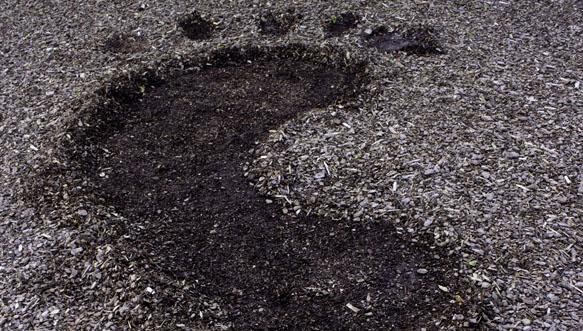Sitting in a swing underneath a grove of oak trees, Scruggs said she and her son, Victor, became alarmed when a long guttural growl penetrated the air from behind their house. Scruggs, who lived in the country all her life, said it sounded like a man being ripped to shreds.
A few minutes later, the growl grew closer, coming from behind her house. Scruggs’ five German Shepherds fell silent, she said. Frightened, she and Victor Scruggs fled inside their home.
“We knew nothing about Bigfoot,” Scruggs said. “I wasn’t a believer. I wasn’t a skeptic. I didn’t know anything about it, but then I started watching ‘MonsterQuest’ and ‘Finding Bigfoot.’ I started playing with it in my head.”
Bigfoot sightings have been reported all across North America. Dana Ehret, a paleontologist at The University of Alabama, grew up with stories like the Jersey Devil ingrained into his childhood. Ehret said he finds sightings of Bigfoot fascinating on a social aspect, but he doesn’t believe they are real.
“A giant seven-foot primate living in the United States going undetected is just impossible,” he said. “We would have found evidence of it by now. The world is shrinking smaller and smaller. I think a seven-foot-tall primate running around Alabama would be seen pretty quickly.”
Scruggs said the growls surrounding her house continued for the next few weeks, coming from the wood line near her house. She and her husband turned the occurrences into a joke. Every evening she would mimic the yells, and every evening, she said it would yell back at her.
But Scruggs said the growls soon turned aggressive and frightened her. During a bad thunderstorm, Scruggs and her husband were watering their cattle when they were surrounded by screaming so loud, Scruggs said she could feel it vibrating her chest.
Jeffery Lozier, a biologist at the University, said scientists never say anything is impossible, but he, too, is skeptical of the existence of a creature like Bigfoot. Lozier said Scruggs might have encountered a mountain lion. Most people probably could have gone their entire lives in the area, Lozier said, and never have seen one. Every time Lozier goes into the forest, he said, he encounters something he’s never seen before.
One of the reasons Ehret believes people jump to Bigfoot when they hear a strange noise versus an animal like a bobcat is their fascination with the unknown. He said it’s fun to consider these creatures being real, but people should recognize they don’t exist.
A few days later, Scruggs said she saw Bigfoot for the first time. She said she could see the silhouette of the creature squatting in the woods before standing up eight feet in height.
Based on analysis, Lozier suggested Scruggs might have seen a black bear in the woods. Based on sightings and records, the places where Bigfoot would live are the same areas populated by black bears.
“It’s very easy to mistake a bear for something like a Bigfoot,” he said. “A lot of times they will stand up on their hind legs. They actually leave footprints that are very similar when they slide through mud. I imagine if you saw a black bear on it’ hind legs at dusk, your mind would play tricks on you, too.”
Scruggs insisted it wasn’t like any animal she had ever seen. For the next year, she said she was a prisoner within her own home. She refused to go outside by herself, and she made sure she kept a loaded pistol with her at all times.
“I know what I saw,” she said. “Before that, I was always outgoing. Growing up, the woods was my playground.”
Deciding to spread the word, Scruggs started an activist group, Bigfooting in Alabama, which has almost 700 members. The group tracks sightings of Bigfoot in Northern Alabama. She also volunteers at the Alabama Bigfoot Society, where she works as a a field investigator, gathering evidence and reports.
Scruggs said she’s found trees stripped of bark, wood structures, fence posts pulled up and large footprints around her property. She said she believes Bigfoot forms territorial markers out of trees. There are many natural animals, Lozier said, that could have stripped bark from trees, including beavers building dams and deer filing down their antlers.
Victor said his mother started the group to promote the protection of Bigfoot.
“The reason she started Bigfooting in Alabama because a lot of Facebook pages want to kill them, and her biggest thing is no kill,” Victor said. “They want to let them live a free life like we do.”
Victor said he’s experienced strange occurrences on the property when he was younger, recalling an incident when he was 15. Playing a prank on his mother, Victor said he popped out from behind a car and growled.
“Something yelled back at us. It scared the crap out of me,” he said. “We took off running in the house.”
Many creatures like Bigfoot were created for a variety of different reasons based in reality, Ehret said. The Griffin, a winged animal in the Middle East, was inspired by dinosaur skeletons, and the cyclops was based on the skulls of elephants.
Ehret thinks Bigfoot could have its origins in Native American lore, which used mythological creatures as part of its belief system, and was passed down from generation to generation over the years. He said creatures like Bigfoot were used to scare people.
Since starting the group, Scruggs said there have been many different sightings from as far away as Pale City and Irondale. People are scared to come forward, Scruggs said, because they’re scared of being ridiculed.
“I stepped out, and my biggest critics were my family,” Scruggs said. “They mocked me. They teased me, but when I got that first recording, their jaws dropped.”
In 2009, Lozier wrote an academic paper using Sasquatch as an example to show how convincing species models could be based on questionable inaccurate public data. The tongue-in-cheek paper used eyewitness accounts and footprint recordings to show species distribution for Bigfoot and how many of the sitings could be a case of mistaken identity.
Both Lozier and Ehret said it was possible that a creature like Bigfoot existed billions of years ago. At one time, giant apes and seven-foot grass sloths roamed the earth, but both professors said they don’t believe Bigfoot is going to be found.
Lozier said there’s not enough credible evidence to support Bigfoot. He said there would have to be many Bigfoot creatures running around in the woods to have a sustainable population. The odds of not coming across one, he said, would be unlikely.
“It boggles the mind there wouldn’t be pictures or a dead body or a skeleton,” Lozier said. “We find skeletons of things that have been extinct for millions of years, so why wouldn’t we find a skeleton of a creature that died weeks ago?”
The reason for the recent activity in Tuscaloosa, Scruggs said, is due to deforestation in northern Tuscaloosa. Forests had been stripped to nothing but bare land. She believes they lost their homes and had nowhere else to go.
“I’m not trying to stop the timber cutting,” she said. “They’re welcome to stay there as long as they don’t hurt my dogs. I would love to see some type of law to protect them, so they won’t be harassed.”
Citing several hoaxes involving fake Bigfoot corpses, Ehret said some opportunists use people’s belief in Bigfoot to gain notoriety and fame, but Scruggs, an ordained minister, insisted she isn’t lying.
“Why would I want to destroy my reputation?” Scruggs said. “My words will not change when I stand before the Lord.”







